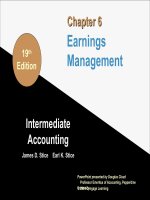MicroEconomics 5e by besanko braeutigam chapter 06
Bạn đang xem bản rút gọn của tài liệu. Xem và tải ngay bản đầy đủ của tài liệu tại đây (578.28 KB, 44 trang )
Chapter 6
Inputs and Production Functions
Chapter Six Overview
1.Motivation
3.The Production Function
Marginal and Average Products
Isoquants
The Marginal Rate of Technical
Substitution
5.Technical Progress
6.Returns to Scale
7.Some Special Functional Forms
Chapter Six
Production of Semiconductor Chips
“Fabs” cost $1 to $2 billion to
construct and are obsolete in 3 to 5
years
Must get fab design “right”
Choice: Robots or Humans?
Up-front investment in
robotics vs. better chip
yields and lower labor costs?
Capital-intensive or laborintensive
production
process?
Chapter Six
Key Concepts
Productive resources, such as labor and capital
equipment, that firms use to manufacture goods and
services are called inputs or factors of production.
The amount of goods and services produces by the firm
is the firm’s output.
Production transforms a set of inputs into a set of
outputs
Technology determines the quantity of output that is
feasible to attain for a given set of inputs.
Chapter Six
Key Concepts
The production function tells us the maximum possible
output that can be attained by the firm for any given
quantity of inputs.
Production Function:
• Q = output
• K = Capital
• L = Labor
Q = f ( L, K )
The production set is a set of technically feasible
combinations of inputs and outputs.
Chapter Six
The Production Function & Technical Efficiency
Q
Production Function
Q = f(L)
D
C
•
•A
•
•B
Production Set
L
Chapter Six
The Production Function & Technical Efficiency
• Technically efficient: Sets of points in the
production function that maximizes output
given input (labor) Q = f ( L, K )
• Technically inefficient: Sets of points that
produces less output than possible for a
given set of input (labor) Q < f ( L, K )
Chapter Six
The Production Function & Technical Efficiency
Chapter Six
Labor Requirements Function
• Labor requirements function
L = g (Q)
Example:
L=Q
for production function
Q= L
2
Chapter Six
The Production & Utility Functions
Production Function
Utility Function
Output from inputs
Preference level
from purchases
Derived from
technologies
Derived from
preferences
Cardinal(Defn: given Ordinal
amount of inputs
yields a unique and
specific amount of
output)
Marginal Product
Marginal Utility
Chapter Six
The Production & Utility Functions
Production Function
Utility Function
Isoquant(Defn: all
possible
combinations of
inputs that just
suffice to produce a
given amount of
output)
Marginal Rate of
Technical
Substitution
Indifference Curve
Marginal Rate of
Substitution
Chapter Six
The Production Function & Technical Efficiency
Production Function Q = K1/2L1/2 in Table Form
K: 0
10
20
30
40
50
L:
0
0
0
0
0
0
0
10
0
10
14
17
20
22
20
0
14
20
24
28
32
30
0
17
24
30
35
39
40
0
20
28
35
40
45
50
0
22
32
39
45
50
Chapter Six
Total Product
• Total Product Function: A single-input production
function. It shows how total output depends on the
level of the input
• Increasing Marginal Returns to Labor: An increase in
the quantity of labor increases total output at an
increasing rate.
• Diminishing Marginal Returns to Labor: An increase in
the quantity of labor increases total output but at a
decreasing rate.
• Diminishing Total Returns to Labor: An increase in the
quantity of labor decreases total output.
Chapter Six
Total Product
Chapter Six
The Marginal Product
Definition: The marginal product of an input is the change in
output that results from a small change in an input holding the
levels of all other inputs constant.
MPL = ∆Q/∆L
• (holding constant all other
inputs)
MPK = ∆Q/∆K
• (holding constant all other
inputs)
Example: Q = K1/2L1/2
MPL = (1/2)L-1/2K1/2
MPK = (1/2)K-1/2L1/2
Chapter Six
The Average Product & Diminishing Returns
Definition: The average product of an input is equal to the
total output that is to be produced divided by the quantity
of the input that is used in its production:
APL = Q/L
APK = Q/K
Example:
APL = [K1/2L1/2]/L = K1/2L-1/2
APK = [K1/2L1/2]/K = L1/2K-1/2
Definition: The law of diminishing marginal returns
states that marginal products (eventually) decline as
the quantity used of a single input increases.
Chapter Six
Total, Average, and Marginal Products
L
6
12
18
24
30
Q
30
96
162
192
150
APL
5
8
9
8
5
Chapter Six
MPL
11
11
5
-7
Total, Average, and Marginal Products
Chapter Six
Total, Average, and Marginal Magnitudes
TPL maximized where MPL is
zero. TPL falls where MPL is
negative; TPL rises where
MPL is positive.
Chapter Six
Production Functions with 2 Inputs
• Marginal product: Change in total product
holding other inputs fixed.
Change in the quantity of output, Q
MPL =
Change in the quantity of Labor, L
∆Q
MPL =
∆L
K is held const
∆Q
MPK =
∆K
Chapter Six
K is held const
L is held const
Isoquants
Definition: An isoquant traces out
all the combinations of inputs
(labor and capital) that allow that
firm to produce the same quantity
of output
And…
Chapter Six
Isoquants
Chapter Six
Isoquants
K
All combinations of (L,K) along the
isoquant produce 20 units of output.
Example:
Q = 20
Slope=∆K/∆L
Q = 10
L
0
Chapter Six
Marginal Rate of Technical Substitution
Definition: The marginal rate of technical substitution measures the
amount of an input, L, the firm would require in exchange for using a
little less of another input, K, in order to just be able to produce the
same output as before.
MRTSL,K = -∆K/∆L (for a constant level of output)
Marginal products and the MRTS are related:
MPL(∆L) + MPK(∆K) = 0
=>
MPL/MPK = -∆K/∆L = MRTSL,K
Chapter Six
Marginal Rate of Technical Substitution
• The rate at which the quantity of capital that can be
decreased for every unit of increase in the quantity
of labor, holding the quantity of output constant,
Or
• The rate at which the quantity of capital that can be
increased for every unit of decrease in the quantity
of labor, holding the quantity of output constant
Therefore
Chapter Six









